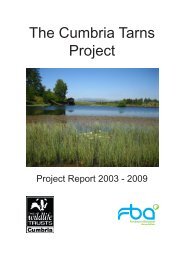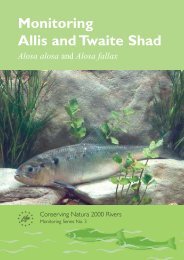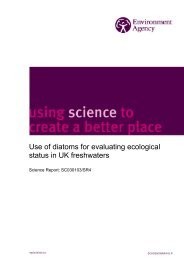Groundwater HIA post edit - FreshwaterLife
Groundwater HIA post edit - FreshwaterLife
Groundwater HIA post edit - FreshwaterLife
You also want an ePaper? Increase the reach of your titles
YUMPU automatically turns print PDFs into web optimized ePapers that Google loves.
5 Monitoring<br />
5.1 Purpose of monitoring<br />
The subject of monitoring has been mentioned briefly several times already in this<br />
report, but will now be discussed in much more detail. This chapter is by no means an<br />
exhaustive treatment of the subject, but serves to highlight the main issues of<br />
relevance to <strong>HIA</strong>. The focus of this section is on monitoring water levels and flows, but<br />
monitoring can also include water quality sampling and ecological surveys. In the<br />
context of groundwater abstraction, the main purposes of monitoring are as follows:<br />
• To establish the baseline environmental conditions before the<br />
commencement of abstraction.<br />
• To fill gaps in the knowledge of the hydrogeology and hydrology of the area<br />
around an abstraction. In other words, to improve the conceptual model by<br />
reducing the uncertainty.<br />
• To demonstrate compliance with conditions attached to relevant abstraction<br />
licences or discharge consents.<br />
• To trigger mitigation measures or temporary cessation of abstraction, if the<br />
water level in a receptor (such as a wetland) falls below an agreed trigger<br />
level, for example.<br />
• To provide early warning of adverse impacts on receptors such as sensitive<br />
water-dependent ecosystems, or other abstractions.<br />
• To accumulate data during the lifetime of a time-limited licence that can be<br />
used when the time comes to review the licence.<br />
5.2 Principles of monitoring<br />
In some cases, monitoring data are collected haphazardly, without any clear idea of<br />
why certain types of data are being collected. Again in the context of groundwater<br />
abstraction, the main principles of monitoring are as follows:<br />
• The overall objectives of the monitoring system should be clearly defined.<br />
There will probably be more than one objective, and these are likely to be<br />
related to the main purposes described above. It is a good discipline to<br />
write these objectives down, if only to focus the mind on what the<br />
monitoring system is trying to achieve.<br />
• The design of the monitoring system should be based on a good<br />
conceptual model. Having said that, it may of course be that there is<br />
significant uncertainty about the conceptual model, which the monitoring is<br />
trying to address. The design should therefore be based on the best<br />
current understanding of the conceptual model, with the design reviewed<br />
and the system adapted as understanding increases.<br />
• The design of the monitoring system should be risk-based, that is, the<br />
burden of monitoring effort should be reasonable and appropriate for the<br />
environmental risks associated with the abstraction in question. One way<br />
to achieve this is to focus the monitoring on the water-dependent features<br />
44 Science Report – Hydrogeological impact appraisal for groundwater abstractions

















